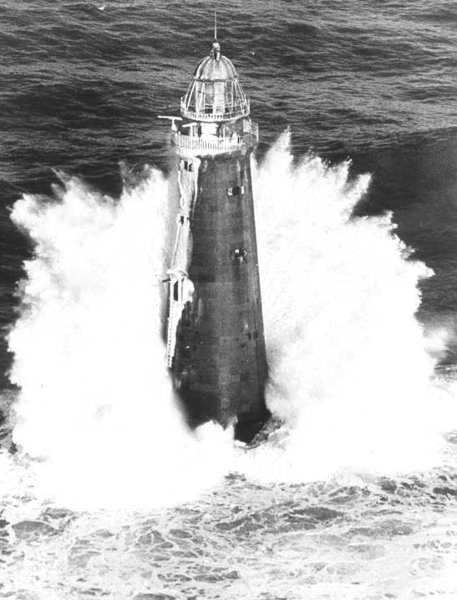Minot's Ledge is a wave-swept rock formation in a rocky area of ocean about a mile off the Cohasset shore near Boston. Numerous serious shipwrecks prompted the government to erect a beacon there, and construction began in the summer of 1847.
The light, constructed on tall iron legs, was put into operation on January 1, 1850. Designers believed that the water would flow freely through the legs, leaving the lighthouse intact. But a terrible winter storm toppled it in 1851, killing the two assistant keepers.
The replacement lighthouse, built of granite blocks between 1855 and 1860, still stands. Considerable foundation preparation along the narrow ledge of rock secures the base of the lighthouse. Interlocking granite blocks provide stability against raging Atlantic storms.
Facts
- The first task in building the new lighthouse was to remove the pilings from the first lighthouse and insert a new iron framework into the remaining piling holes. The new framework was intended to anchor the stone masonry to the rock ledge. The work was done over the period April 1 through September 15, 1855. In January 1856, a violent Atlantic storm blew the New Empire into the piling, completely destroying framework.
- Over a three-year period, a circular base, 30 feet in diameter, was excavated into Minots Ledge rock. New dowels nearly 25 feet high, or as high as the 12th course of granite masonry were anchored into the rock.
- Three things were necessary, a perfectly smooth sea, a dead calm, and low spring tides. This could only occur six times during any one lunation, three at full moon and three at the change, said Captain Barton Stone Alexander. During 1855, only 130 hours of work could be performed at sea; in 1856, 157 hours; in 1857, 130 hours; and in 1858, 208 hours.
- Samples of granite from many locations were submitted and tested, but granite from Quincy was deemed to be the best. Over 3500 tons of rough Quincy granite were delivered to Cohasset.
- Captain John Cook, a master seaman and rigger, devised the model for the derrick that was used to lift the massive granite blocks onto the lighthouse.
- Each stone was hand chiseled in an interlocking dovetailed pattern so that it fit perfectly with its neighboring stones and those above and below it. A total of 1079 stones were crafted, weighing a total of over 2350 tons. The blocks for each course were fitted together on shore to assure perfect fit before being transported to the Ledge.
- It was July 1857 before the laying of stone could commence, and another year before the underwater construction work was completed. Once the stonework was above the tidal range, construction proceeded more rapidly.
- The total cost was approximately $300,000.
- Captain Barton Stone Alexander, a United States Military Academy graduate with the United States Corps of Engineers, was chosen to develop and finalize the design and oversee construction.
- The lighthouse has withstood every gale since 1860. The strongest waves cause nothing by a strong vibration. On some occasions the seas have actually swept over the top of the structure with no more damage than that caused by a few leaky windows.
Resources
- Snow, Edward Rowe. The Story of Minot's Light. Boston, Massachusetts: Yankee Publishing Company, 1940.



